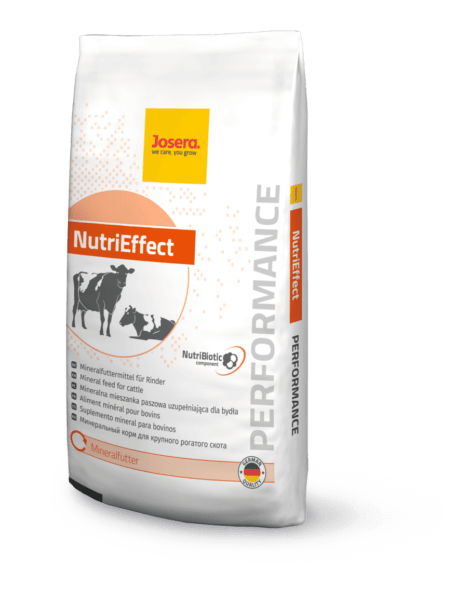Water as a solvent
As a solvent, water dilutes the feed pulp and thus promotes its mixing. Water-soluble nutrients can dissolve from the feed and be absorbed. In addition, numerous enzymes that break down nutrients are only active in the liquid medium. Water thus increases feeding efficiency.
The fluid content of the intestine also determines the activity of the desired intestinal flora. Thus, water stabilizes intestinal health and, consequently, the body’s defenses.
Metabolic waste products/toxins require a minimum amount of water to be excreted by the kidneys.
Electrolyte and water balance
Trace elements and minerals absorbed through the feed are also dissolved in the body water. Sodium, potassium, magnesium, calcium, phosphate, sulfate, chloride fulfill a variety of functions in the metabolism as electrolytes. Among other things, they enable the electrical conduction of nerves, heart function and muscle contraction through special distribution systems. However, their function is also to keep sufficient water in the body to maintain circulation via volume. The goal of the organism is a balance of supply of water through drinking, food and oxidation water from the metabolism and excretion through skin, respiration, feces, urine, milk. To produce one liter of milk, 4-5l of water are required. With a milk yield of 40kg, approximately 150l of water is required at outside temperatures of 27°C. Especially with high amounts of concentrate, the ration has a high average dry matter content, so that the proportion of water supply from the feed is reduced.
Water as a transport system
In the body, water is found as a component of the blood in the blood vessels and as lymph in the lymphatic vessels. Here it is an essential component of a transport system for oxygen, cells, hormones, enzymes, nutrients, immunoglobulins, metabolic products, etc. Through complicated hormonal and neuronal control systems, there is a continuous build-up, conversion and degradation of substances and structures:
The right building block is in the right place at the right time. But every cell in the body also contains water. The concentration of the electrolytes dissolved in it – especially potassium – is kept constant under energy consumption. Only in this way can metabolic processes run smoothly.
Acid-base balance
This also applies to H – ions concentration. Acidification (metabolic acidosis) of the organism can occur when there is a high protein supply, especially when the body’s own protein is broken down in a state of hunger. However, organic acids such as lactate (rumen acidosis) or keto acids (ketosis) as well as nutrients containing phosphate and sulfate also lead to an excess of protons in the blood.
Bicarbonate serves as a buffer by binding both hydrogen ions and ammonium ions produced in the protein metabolism (urea cycle in the liver).
In acidosis, the rate of urea synthesis in the liver decreases to save bicarbonate.
Thermoregulation through water
The body temperature must also be kept constant within narrow limits. It fluctuates around 37°, and already above 42° there is a risk of protein denaturation. Water is involved in thermoregulation via evaporation through the skin (sweat) and the respiratory tract (accelerated breathing).
Water deficiency
A lack of water leads to performance depression, reluctance to move, and even muscle cramps and immobilization. Since water is also involved in the formation of synovial fluid, this can also lead to a lack of movement.
In the case of water deficiency, the blood thickens, the transport slows down, reaction products and degradation products are no longer supplied quickly enough to the body’s needs or transported away and excreted. At the same time, the heart has a higher energy requirement because it has to pump more blood. Even a latent undersupply of water leads to an accumulation of metabolic products, since they can no longer be sufficiently dissolved and excreted. Here, they slow down the metabolism and thus the performance and accelerate the aging process of the cells.
Water supply at hot temperatures
In addition to its function as a transport and solvent for nutrients and waste products, water also serves to regulate heat. Therefore, there is a high correlation with ambient temperature. This means that at temperatures of 25-35°C the requirement increases to 4-10l/kg DM intake and at over 35°C it is 8-15l/kg DM intake.
In hot weather, there is an additional demand for water, since water evaporates through the skin and respiratory air for thermoregulation. If this additional demand is not met, microbes in the rumen and intestine die. As a result, rumen fermentation may be disturbed. The feed is less easily digested and the energy yield decreases as a result.
With JOSERA NutriEffect you can stabilize the intestinal health of your cows and thereby increase nutrient efficiency!
Your advantages:
- improved fertility and thus lower insemination costs
- increased nutrient concentration in the blood and thus higher milk yields
- lower veterinary costs due to reduced susceptibility to disease in the animal
- improved hoof and udder health
- more stable immune system due to increased nutrient density
- strengthening of the immune system and thus more vital animals
At the same time, feed intake decreases due to a longer retention time of the feed in the rumen. Milk fat and milk protein decrease. The quantity of milk also decreases because, on the one hand, the glucose supply decreases due to the reduced energy yield in the rumen and intestine. As a result, less lactose is formed. On the other hand, too little water is available for milk formation, which takes place according to the osmosis principle.
A water deficit reduces the water content in the blood. It thickens. Consequently, the flow rate decreases, the dissolution of nutrients decreases and they reach their destination only slowly. In addition, detoxification decreases, waste products accumulate. The osmotic pressure in the cells decreases. They can no longer perform their specific functions and eventually die prematurely. The cells of the intestinal mucosa are particularly important here, as they protect the body from foreign substances from the outside world. Holes develop in this otherwise gapless protective layer. Microbes and foreign substances can penetrate directly into the body tissue, with fatal consequences.
Oxygen and nutrient deficiencies, as well as exposure to harmful substances, lead to a reluctance to move. The body temperature rises, further microbes die as a result. A vicious circle develops. Acute mastitis with blood poisoning, liver failure, cardiovascular failure are the result. Late consequences are often fertility problems. Heat periods of increasing length and intensity make it necessary to reconsider the water supply of cows and to make adjustments in order to minimize economic damage due to reduced performance, health problems, e.g. acute udder infections and late effects in the context of fertility, as well as acute deaths.
You might be interested in the following contents:
Beta-carotene – for fertile cows & healthy calves
In the winter months, fertility problems increasingly occur in many dairy herds. Still heat, returning to oestrus and re-insemination can accumulate. Follicular cysts and embryonic fruit death are also fairly common at this time of year.
How does feed influence the milk ingredients?
Milk is still one of the world’s staple foods. The development of milk production in Germany reflects the enormous performance potential of herds on farms. Read more about production and the nutritional status of dairy cows.




